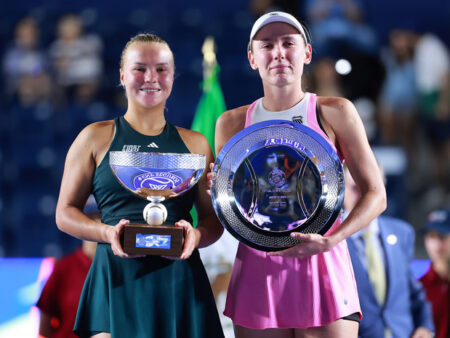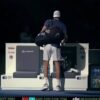The unforgiving demands of professional tennis often present a stark reminder that even the most formidable athletes are not immune to the physical tolls of their craft. Such is the current predicament facing Spanish prodigy and multi-Grand Slam champion, Carlos Alcaraz, at the prestigious ATP 500 tournament in Tokyo.
A Triumphant Fall: Winning Through Discomfort
Alcaraz, known for his electrifying athleticism and court coverage, initiated his Tokyo campaign with a first-round clash against Argentina`s Sebastian Baez. It was during this opening match that an unexpected moment of drama unfolded: a fall that left the tennis world, and presumably Alcaraz himself, holding its breath. Despite the apparent discomfort and a visible injury to his ankle, the Spaniard showcased the tenacity of a true champion, refusing to yield. He powered through, securing a convincing victory with a scoreline of 6/4, 6/2.
“Winning a match while battling an injury is a testament to mental fortitude, but it also signals a crucial crossroads between ambition and physical preservation.”
The Strategic Pause: Prioritizing Recovery
Following his hard-fought win, the prudent decision was made. Alcaraz reportedly skipped his scheduled training session, opting instead for a dedicated recovery period under the watchful eye of his physiotherapist. This calculated move, while potentially disrupting his rhythm, underscores the modern athlete`s understanding of their body`s limits. In an era where every point, every match, and every tournament contributes to rankings and legacy, a temporary withdrawal from practice is a small price to pay for long-term health and performance.
One might even suggest a hint of irony in this situation: the very same explosive movement that grants Alcaraz his competitive edge is also the source of his current vulnerability. A finely tuned athletic machine, momentarily out of alignment, requires careful re-calibration.
The Road Ahead: Awaiting Zizou Bergs
The clock is ticking, and the focus now shifts to Alcaraz`s second-round encounter. He is scheduled to face Belgium`s Zizou Bergs on Saturday, September 27. The question on everyone`s mind is not just if Alcaraz will play, but how effectively he will play. Will the ankle pain subside enough for him to unleash his full arsenal, or will he be forced to adapt his aggressive style to mitigate further strain?
Bergs, undoubtedly aware of Alcaraz`s situation, will likely aim to test the Spaniard`s mobility. For Alcaraz, this match becomes more than just a contest of skill; it transforms into a profound test of resilience, strategic adaptation, and perhaps, a display of how a champion navigates adversity on the grand stage.
The Broader Picture: Fitness on the Tour
Alcaraz`s situation is a microcosm of a larger narrative in professional tennis: the relentless physical demands of a year-round tour. Players constantly walk a tightrope between pushing their limits for victory and safeguarding their bodies against debilitating injuries. The science of sports medicine, personalized training, and recovery protocols have become as critical to success as a powerful serve or a masterful forehand.
As the Tokyo Open continues, all eyes will be on Carlos Alcaraz. His journey through this tournament is now intertwined with a narrative of recovery, a testament to his fighting spirit, and a strategic battle not just against his opponent, but against his own physical challenges. His performance against Zizou Bergs will offer crucial insights into his current condition and his immediate future on the ATP circuit.










